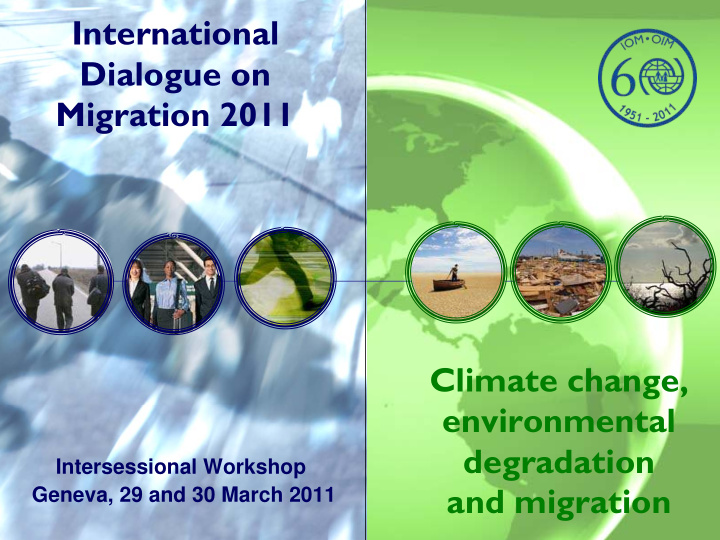



International Dialogue on Migration 2011 Climate change, environmental degradation Intersessional Workshop and migration Geneva, 29 and 30 March 2011
Images of “Environmental Migration”
“The gravest effects of climate change may be those on human migration.” Intergovernmental Panel on Climate Change, 1990 Invites all Parties to undertake “Measures to enhance understanding, coordination and cooperation with regard to climate change induced displacement, migration and planned relocation, where appropriate, at national, regional and international levels.” Paragraph 14 (f) Cancun Agreements, COP15, 2010
Climate Change, Environmental Degradation and Migration – A Complex Nexus • Both natural disasters and environmental degradation can induce migration. • Climate change is likely to exacerbate these events and processes. • Environmental migration is a multi-causal phenomenon.
Climate Change, Environmental Degradation and Migration – A Complex Nexus • Primarily internal migration or cross- border movement between neighbouring countries • Spectrum from temporary to permanent migration
Environmental Migrants - A Working Definition “ Environmental migrants are persons or groups of persons who, for compelling reasons of sudden or progressive change in the environment that adversely affects their lives or living conditions, are obliged to leave their habitual homes, or choose to do so, either temporarily or permanently, and who move either within their country or abroad.” IOM 2007
Migration for Survival In the case of acute natural disaster, migration is often a strategy of “last resort”. The distinction between “forced” and “voluntary” migration is blurred.
Migration as Adaptation Migration is one possible adaptation strategy. Often, the most vulnerable are unable to move.
Gaps in capacities and resources Capacity Building: Strengthening knowledge, abilities, skills, resources, structures and processes needed to achieve goals effectively and sustainably and to adapt to change. World Migration Report 2010
Building capacities Three main areas: • Knowledge base • Institutional, policy and legal frameworks • Operational and technical intervention
Building capacities Knowledge base • Systematic data collection, data comparability, modelling and policy evaluation • Sharpened definitions and terminology • Better understanding of causalities (especially regarding slow-onset disasters and internal migration)
Building capacities Institutional, policy and legal frameworks • Legal provisions for protection and assistance to environmental migrants (e.g. temporary protection / temporary authorization to stay) • Linking of environmental considerations, migration management policies, and other policy domains (especially development and humanitarian action) • Empowerment of local actors
Building capacities Operational and technical intervention • Disaster risk reduction (DRR) measures • Implementation of rights-based approaches to disaster response (focus on vulnerable groups) • Operationalizing migration as an adaptation strategy (e.g. labour migration programmes)
Managing environmental migration – IOM’s approach 5. Address long- term challenges: durable solutions, migration, development and 1. Prevent forced adaptation Address migration, facilitate migration as Prevent adaptation 4. Mitigate impacts of forced Mitigate or mass migration 2. Prepare for Prepare displacement 3. Manage Manage and relocation migration: assistance and protection
IOM’s role and responsibility Policy (Strategy Points 2,3,7) • Policy dialogue (national, regional, international) • Focus on coherent and proactive policymaking Research (Strategy Point 4) • Inter-disciplinary research • Links between research and policy communities Operations (Strategy Point 9) • Humanitarian response to displacement induced by natural disaster / complex emergencies • Global cluster lead for Camp Coordination and Management in Natural Disasters • Reducing vulnerability and promoting adaptation to environmental and climate change
Conclusions Objectives of managing environmental migration: • Minimize forced migration resulting from environmental factors • Ensure protection and assistance and devise durable solutions where displacement is inevitable • Facilitate the role of migration as an adaptation strategy to climate change
Conclusions Way forward: • Answer open questions about the nexus and its impacts • Situate responses to environmental migration at the intersection between migration, development and humanitarian domains • Advance debate through regional consultations and collaborative approaches
Thank you!
Recommend
More recommend